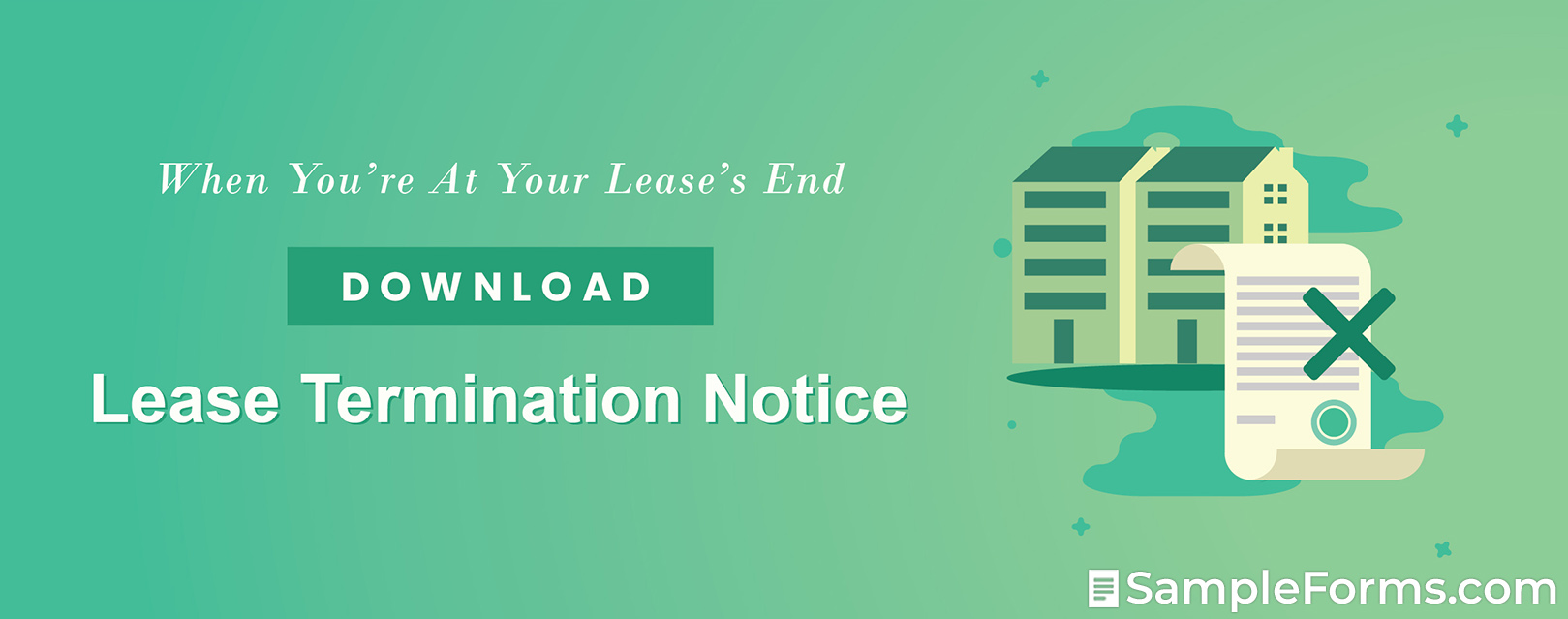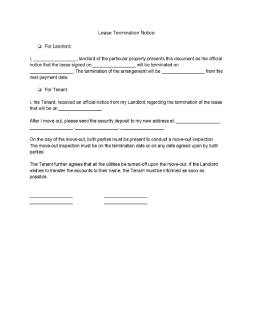- Eviction Notice Forms
- Power of Attorney Forms Forms
- Bill of Sale (Purchase Agreement) Forms
- Lease Agreement Forms
- Rental Application Forms
- Living Will Forms Forms
- Recommendation Letters Forms
- Resignation Letters Forms
- Release of Liability Agreement Forms
- Promissory Note Forms
- LLC Operating Agreement Forms
- Deed of Sale Forms
- Consent Form Forms
- Support Affidavit Forms
- Paternity Affidavit Forms
- Marital Affidavit Forms
- Financial Affidavit Forms
- Residential Affidavit Forms
- Affidavit of Identity Forms
- Affidavit of Title Forms
- Employment Affidavit Forms
- Affidavit of Loss Forms
- Gift Affidavit Forms
- Small Estate Affidavit Forms
- Service Affidavit Forms
- Heirship Affidavit Forms
- Survivorship Affidavit Forms
- Desistance Affidavit Forms
- Discrepancy Affidavit Forms
- Guardianship Affidavit Forms
- Undertaking Affidavit Forms
- General Affidavit Forms
- Affidavit of Death Forms
Lease Termination Notice
The base term for a residential lease agreement is twelve months or a whole year. Some variations can be shorter, such as those that last for six months, while others can be longer than a year. On the other hand, commercial lease agreements can average at three to five years. Just as how lease arrangements start with signing a formal document, a lease termination notice also determines its end. This document serves as a reminder from the landlord and can also be a response from the other party as options for the tenant are available. If you are thinking about using one to manage your tenants better, continue reading this article. Read More
Lease Termination Notice
What Is a Lease Termination Notice?
The termination process of a lease is not as immediate as it seems, despite the presence of its end date in the signed lease agreement. Several factors can affect the course of the lease arrangement. Apart from terminating it on time, the lease can be cut short or extended for more months or years. The document that will notify a significant change is the lease termination notice. The landlord uses this document to inform the tenant that the lease is about to end and leave the decision to the tenant. However, it can also be useful if the tenant violates the stipulations of the contract that warrants for termination of the agreement.
How Do You Create a Lease Termination Notice?
Notices, by itself, are public documents that notify the involved parties about legal proceedings that can protect their rights, and make the parties aware of their duties and obligations. Following this definition, a lease termination notice provides both parties with information to help them prepare for their next course of action regarding the lease. If you are thinking about creating one, here are some steps with key points that will help you write an effective termination notice.
1. Know the Reason for Sending the Notice
Apart from the end of the term, terminating a lease agreement can have different bases. Before sending a lease termination notice to your tenant, you must come up with a firm decision regarding the reason behind it. If there are no violations, you can send the notice without additional information. But, if there are issues regarding delayed payment or violations, crucial information supporting the claim must be included in the notice. Therefore, you must finalize the reason behind sending the notice before sending a copy to the tenant.
2. Review the Signed Lease Agreement
The first part of the notice requires some details that are found in the signed lease agreement. It requires the date when the document was signed, the set termination date, and the notice-period for sending a termination notice. Both parties have agreed on these details upon signing the lease agreement. Moreover, if the tenant committed violations, you can use the agreement as a reference to properly weigh the gravity of the violation.
3. Provide the New Mailing Address, if Available
The landlord is not the only user of this termination notice. The tenant can also this document to respond to the notice sent by the landlord. This method of correspondence is preferred according to a stipulation in the prior agreement. If the tenant chooses to respond, they can use the latter part of the document, which requires them to include their new mailing address. The landlord can use this information when they need to send the remaining possessions of the tenant.
4. Read and Agree to the Supporting Stipulations
A critical stipulation included in the lease termination notice is the condition regarding a moving out inspection. The notice specifies that representatives must be present on the moving out date to conduct a thorough inspection of the entire property. Other conditions regarding the inspection are also indicated in the document. Both parties must be aware of this condition before signing the document.
5. Make Sure the Recipient Receives It
Sending out notices must follow a certain notice-period for it to take effect. In most cases, a two-week notice-period is ideal, depending on the understanding of both parties. To strictly follow this timeframe, the sending party must make sure that the recipient received the document on its intended date. If not, a late acceptance of the notice may cause trouble when it comes to its execution. Recently, both landlords and tenants resort to sending notices through email because of its convenience and efficiency.
FAQs
Does lease termination affect my credit score?
Terminating a lease will not be reflected on your credit record. However, lease termination can significantly affect your credit score, especially when the agreement ends with unpaid rent or other kinds of debt.
What are the reasons for receiving a termination notice?
The landlord has several reasons for sending a termination notice. The first and most obvious reason is that the agreement is near its termination date. The notice serves as a reminder for both parties. Another reason for sending a notice is when the tenant committed a violation of the terms of the agreement. The breaches include late payment of rent, committing illegal acts, or conducting activities in the premises that are against the signed document.
Are lease termination fees legal?
The fees indicated in a lease termination notice are legal because these fees often refer to delayed rent, damages, or fines for doing something prohibited.
Is lease termination similar to eviction?
A lease termination notice can be used for these two different situations. A lease termination notice, first and foremost, notifies the tenant’s party that the agreement is about to end. However, its use for evictions is to inform the tenant of the landlord’s decision to evict them from the property because of particular reasons, such as contract breach or non-payment.
Can I email the lease termination notice?
Although the traditional way of sending notices is still preferred, advantages come with sending the notice electronically. Most tenants have direct access to it through their devices. Thus, there will be a higher chance that they can receive the notice earlier than sending the document personally.
Lease agreements are bound by formalities. Starting with a lease application and agreement, its end is notified through a lease termination notice. A landlord has the choice to send this notice nearing the end of the agreement or if the tenant committed violations that warrant an eviction. Either way, this notice is an essential document for landlords who want to keep their tenants in check.

